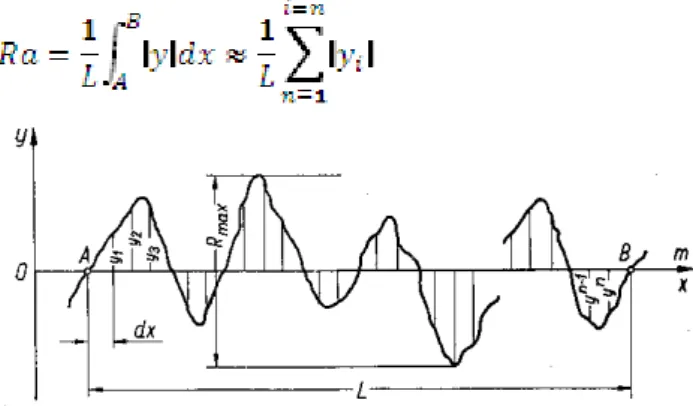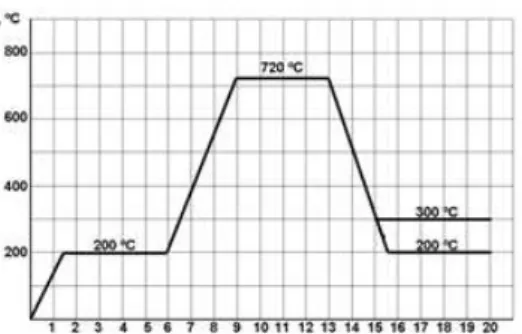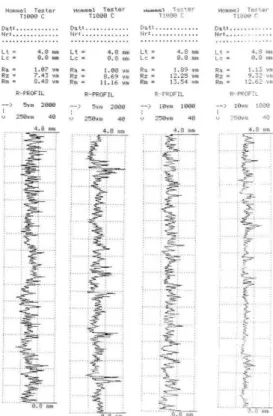A R C H I V E S
o f
F O U N D R Y E N G I N E E R I N G
Published quarterly as the organ of the Foundry Commission of the Polish Academy of Sciences
ISSN (1897-3310) Volume 11 Special Issue
3/2011
157 – 162
29/3
Roughness of surface of vacuum castings
prepared in plaster moulds
M. Pawlak
Department of Materials Engineering and Production Systems, Technical University of Lodz 1/15 Stefanowskiego Str., 90-924 Łódź, Poland
Corresponding author. E-mail address: marek.pawlak@p.lodz.pl
Received 09.07.2011; accepted in revised form 27.07.2011
Summary
The results of researches on surface roughness of CuSn10 and CuSn5Zn5Pb5 bronzes and aluminum AlSi11 alloy vacuum castings prepared in plaster moulds are presented in this paper. Test samples were cut from stripe castings of dimensions 100x15x1 mm. Surfaces were carefully cleaned with use of soft brush than in ultrasonic washer and dried.
Experimental castings were prepared in moulds made of two types of plaster. Cast temperatures were 1120 and 1200°C for bronzes and
700 and 800°C for silumin. Temperatures of the mould were 500 and 600°C for bronzes and 200 and 300°C for aluminum alloy. The
roughness measurements were carried out with use of Hommelwerke Tester T1000. The average arithmetic deviation of roughness profile Ra, the ten-point height of irregularities Rz and maximum peak to valley height Rm, were measured.
It can be stated, on the base of obtained results, that technology of casting in plaster moulds allows preparation of castings of very low
roughness, average Ra=0,88÷1,74µm for bronzes and Ra=0,59÷0,83µm for aluminum alloys. Roughness of the surface depends in fact on
the cast material. Type of plaster and casting parameters have negligible influence on it.
Keywords: M odern casting materials and technologies, Precision castings, Plaster mould, Precision casting surface roughness
1. Introduction
Castings prepared in plaster moulds belong to the group of precision castings [1]. One of the characteristic feature of them is
a low roughness, reported to be Ra=0,8÷3,2µm, however authors
do not provide information on type of castings and moulds [2,3]. Roughness of the castings is determined with use of Ra and Rz parameters (standard PN-87/M -04251), and the Ra parameter is privileged both to Rz parameter and others listed in the standard.
Parameters given in standard PN-87/M -04251 [8]are defined as follows:
Ra – average arithmetic deviation of roughness profile:
Rz – ten-point height of irregularities of surface.
Fig. 2. Scheme of irregularities of surface for define the height of irregularities Rz
Sometimes the Sm(Rmax, Rm) parameter is given determining maximum peak to valley height.
Following parameters influence the quality of the castings surface prepared in typical molding sands [4 ]:
1. Type of mass and preparation. 2. Type of metal and temperature.
3. Preparation of mould and pouring parameters. 4. Cast cleaning procedure.
This matter looks different in the case of plaster moulds. Casting plaster are very fine-grained, and the characteristic setting mechanism causes the creation of smooth skin inside the cavity [5].It can be inferred from this, that type of plaster slightly influences the casting surface roughness.
Type of cast material thus the cast temperature can influence the state of the cast surface, even if the partial destruction of the
shaped cavity surface as a result of thermal and chemical influence of the liquid alloy[6 ].
In case of vacuum cast plaster moulds the procedures of mould preparation and running castings are determined by devices and applied technology [7 ].
Casting prepared with use of discussed method are typically cleaned in the same way, so high pressure cleaner and ultrasonic one are used. Final surface treatment is made with use of pneumatic cleaning by grinding material flow.. Dependently on final requirements, M aterials strongly influencing surface st ate can be used (like corundum sands, carbo-corundum or sharp -edge quartz) or ones removing plaster mass remainders and slightly polishing (like glass balls). The last method does not change the surface state, in the matter of fact.
2. Scope and methodology
The goal of the researches was to determine the influence of plaster mould material type and its temperature at the moment of running as well as liquid Alloy temperature on the surface roughness of the experimental casts..
2.1. Range of researches
The range of materials and temperatures in which tests were carried out, was determined on the base of preliminary researches.
Set of parameters is presented in table 1.
Table 1.
M aterials and parameters of experimental casts for roughness measurements, preparation
M old material Plaster powder Gold Star XL (GS) Plaster powder Prima Cast (PC)
Casting material CuSn10
Pouring temperature, tzal, °C 1200 1120 1200 1120
M ould temperature tf, °C 500 600 500 600 500 600 500 600
Sample mark 1-1 1-2 1-3 1-4 2-1 2-2 2-3 2-4
Casting material CuSn5Zn5Pb5
Pouring temperature, tzal, °C 1200 1120 1200 1120
M old temperature tf, °C 500 600 500 600 500 600 500 600
Sample mark 3-1 2-2 3-3 3-4 4-1 4-2 4-3 4-4
Casting material AlSi11
Pouring temperature, tzal, °C 800 700 800 700
M old temperature tf, °C 300 250 300 250 300 250 300 250
2.2. Materials
a) jewelry plaster bonded investment powder Gold Star XL by Hoben of following properties [9]:
water/gypsum ratio for ø 120 mm – W/G=0,40 setting time: start: twp=16’20”
finish: twk=18’00”
bendig strength after 2 h Rgu=1,2M Pa,
b) jewelry plaster bonded investment powder Prima Cast by WhipM ix of following properties [3]:
water/gypsum ratio for ø 120 mm W/G=0,40
setting time : start: twp=17’40’’
finish : twk=20’00’’
bending strength after 2h Rgu=1,1 M Pa.
c) model wax (green) by Vigor in form of sheets of thickness g=0,8; 0,6; 0,5 mm,
d) jewelry injection wax (green) by Castaldo for model slips
preparation of thickness g=1,0 and 2,0 mm and rods of ø 10 and ø5 mm.
e) distilled water,
f) CuSn10 bronze of chemical composition Sn=10,24%, Pb=0,537%, Zn=0,345%, Ni=1,64%, Sb=0,122%.
g) CuSn5Pb5Zn5 bronze of chemical composition Sn=4,66%, Pb=5,93%, Zn=5,46%, Ni=0,988%, Fe=0,133%.
near eutectic silumin AlSi11 Si=10,89%, Fe=0,648%, M n=0,311%, M g=0,142%, Zn=0,0488%, Ti=0,0509%.
2.3. Researches methods
2.3.1. Mixing the slurry
The slurry was prepared in vacuum mixer „St. Louis” 82
according to following procedure:
pouring weighted dry plaster powder into the mixer chamber,
degassing during 120 s,
delivery of measured amount of distilled water,
mixing under vacuum during 210 s at rates n=150÷350 rpm.pouring the mass into the tube (inside the vacuum chamber).
2.3.2. Experimental model
The experimental cast consisting of four wax straps of dimensions 15x100x1 mm placed vertically around sprue
ofdiameter Ø10 mm (Fig.3).
Fig. 3. The wax pattern of experimental casting for researches roughness of surface
2.3.3. Experimental mold
A. M old preparation
Experimental moulds were prepared in heat -resisting steel
perforated cylinders of dimensions ø100x220 according to following procedure:
mounting the experimental model on the rubber base, mounting the cylinder in the base seat,
placing the cylinder with the pattern in the pouring chamber
of the „St. Louis 82” mixer,
pouring, under vacuum, the liquid plaster slurry into the cylinder,
removing the mould from the mixer chamber,
setting and preliminary drying of the mould under ambient conditions during 2h.
B. Heat treatment
Dried moulds were baked in box-type resistance furnace APE 800 according to procedure show in figures 4 and 5.
Fig. 5. The scheme of silumin AlSi11 experimental mould heat treatment
2.3.4. Experimental castings preparation
Examined alloys were melted in Vacuum Pressure Casting M achine VC 500D Indutherm in argon atmosphere.
Experimental castings were prepared according to following procedure:
Castings of CuSn10 and CuSn5Zn5Pb5 bronze:
melting and overheating to temperatures, respectively, 1120
and 1200ºC.
Castings of AlSi11 silumin:
melting and overheating to temperatures, respectively, 700
and 800ºC.
Next operations were making the same for all alloys: removing of hot mould from the furnace APE 800 and
placing it in the caster chamber,
checking mould temperature in the canal of sprue, closing the chamber and degassing the mould in vacuum
during 90 s,
casting the mould (from bottom-pour stopper crucible in argon atmosphere),
casting solidification during 120 s removing the cast mould from the chamber,
mounting K type thermocouple in the drilled ø2x80 mm
hole
waiting for 90-300sec for final crystallization (time dependent on the pouring basin volume and lab conditions and was set experimentally)
immersing the mould in water to remove the cast, cleaning the cast by high pressure water cleaner,
2.3.5. Samples preparation
Samples for
surface
roughness measurements were prepared as follows: cutting off sample of length 70mm (70x15x1mm), careful ”wet” cleaning with use of soft brush,
ultrasonic cleaning, drying in the flux of hot air,
final cleaning (polishing)in the flux of glass balls of
diameter ø0,125 mm,
selection of samples from one casting from the viewpoint of defects elimination resulting from micro cracks of the mould or imperfection of wax pattern.
2.3.6. Surface roughness measurement of
experimental casts
Roughness measurement were carried out with use of Hommelwerke Tester T1000.
The accuracy of the surface was determined on the base of measurements of:
average arithmetic deviation of roughness profile Ra, , the ten-point height of irregularities Rz,
maximum peak to valley height Rm,
made on the gauge length Lt=4,8 mm. Such gauge length (in accordance with PN-87/M -04251 for Ra=0,4÷3,2 µm l=0,8 mm) was applied to obtain more reliable results.
The final result of measurement is an average from five gauge length runs.
3. Discussion
Results of measurements are presented in table 2 and 3. Examples of profilograms from the surface of bronze CuSn10 casting made in Gold Star XL plaster mould are presented in Figure 6. Analysis of the test results did not revealed a clear dependences between surface roughness of castings and methods of the preparation. Roughness values are random, independent on casting temperature and temperature and material of the molds. The one regularity that could be observed was that lower roughness parameter Ra showed test casts made of aluminum alloy AlSi11, next bronze casts CuSn10 and the higher value was observed for CuSn5Zn5Pb5 bronze.
Generally it can be assumed that roughness of tested casts is very low, comparable to pressure die casts. It can be clearly observed for aluminum alloy AlSi11 for which measured
parameters are in the range Ra=0,59÷0,83μm (Rz=4,57÷4,92µm). The most Ra values lay in the range 0,59÷0,72µm and the
influence of temperature factor on them is the lowest.
Bronze casts roughness lays in the range Ra=0,88÷1,74μm (Rz=7,07÷12,01µm). The spread of averages of measured
parameters is definitely higher than in case of aluminum casts. This is a result of higher mould and cast metal temperature thus more intensive influence of an alloy on the cavity surface.
In bronze castings the values of Ra>2μm are incidental and
Table 2.
Results of surface roughness of experimental castings made in mould of plaster powder "Gold Star XL" Casting material: CuS n10
Sample Pouring temperature, tzal, °C M old temperature tf, °C
Result of roughness measurement
Ra, μm Rz, μm Rm, μm
1-1
1200 500 0,99 7,73 10,26
1-2 600 0,98 8,52 11,38
1-3
1120 500 1,69 11,82 14,04
1-4 600 1,22 9,28 12,08
Casting material: CuS n5Zn5Pb5
Sample Pouring temperature, tzal, °C M old temperature tf, °C
Result of roughness measurement
Ra, μm Rz, μm Rm, μm
3-1
1200 500 1,67 11,71 14,74
3-2 600 2,58 17,02 25,13
3-3
1120 500 1,58 11,05 13,42
3-4 600 1,14 8,20 10,69
Casting material: AlS i11
Sample Pouring temperature, tzal, °C M old temperature tf, °C
Result of roughness measurement
Ra, μm Rz, μm Rm, μm
5-1
800 300 0,69 4,34 5,66
5-2 250 0,83 4,92 10,24
5-3
700 300 0,64 4,58 8,98
5-4 250 0,69 4,16 6,29
Table 3.
Results of surface roughness of experimental castings made in mold of plaster powder „Prima Cast” Casting material: CuS n10
Sample Pouring temperature, tzal, °C M old temperature tf, °C
Result of roughness measurement
Ra, μm Rz, μm Rm, μm
2-1
1200 500 0,96 6,41 7,90
2-2 600 0,98 7,07 8,60
2-3
1120 500 0,88 6,77 9,38
2-4 600 1,36 9,97 12,73
Casting material: CuS n5Zn5Pb5
Sample Pouringtemperature, tzal, °C M old temperature tf, °C
Result of roughness measurement
Ra, μm Rz, μm Rm, μm
4-1
1200 500 1,28 9,64 13,63
4-2 600 1,74 12,01 14,69
4-3
1120 500 2,60 17,17 21,55
4-4 600 1,50 12,00 19,59
Casting material: AlS i11
Sample Pouring temperature, tzal, °C M old temperature tf, °C
Result of roughness measurement
Ra, μm Rz, μm Rm, μm
6-1
800 300 0,72 4,89 6,89
6-2 250 0,62 3,69 4,81
6-3
700 300 0,59 4,57 7,75
Fig. 6. Examples of profilograms from the surface of bronze CuSn10 castings (samples 1-1 ÷ 1-4). M old material: Gold Star XL
4. Conclusions
Analysis of measurement results allow to formulate following conclusions:
1. Technology of vacuum casting in plaster moulds allows preparation of casts of very low surface roughness. 2. Roughness of casting surfaces depends on cast material. 3. Roughness of casting surfaces does not depend clearly on
the mould material, its temperature and cast material temperature.
Acknowledgements
The work was made as a part of the research project No. N N508 3886 33 financed by founds for science in the years 2007-2010 by the Polish M inistry of Science and Higher Education.
References
[1] Lewandowski L.: Materiały formierskie (Moulding materials), AKAPIT, Warszawa
[2] Nelson C.D.: Plaster M olding, In: M etals Handbook, Vol. 15 Casting, p. 245.
[3] Clegg A.J.: Precision Casting Processes, Pergamon Press, 1991, p. 120-121.
[4] Skarbiński M.: Dokładność wymiarowa odlewów (The accuracy of casting), WN-T, Warszawa 1965, p. 475÷476. [5] Pawlak M .: Proces wysokotemperaturowego wygrzewania
form gipsowych dla odlewnictwa artyst ycznego (The firinggipsummould for artistic casting). Archiwum
Odlewnictwa, PAN, 2006, Nr 19, s. 213÷220.
[6] Pisarek B., Pawlak M .: Selection of the temperature of casting the bronzes to plaster moulds
(Dobórtemperaturyodlewaniabrązów do form gipsowych).
Archives of Foundry Engineering, Vol. 9, Issue 4, October – December 2009.
[7] Instrukcjafirmowamieszalnika St. LOUIS 82 B/P firmy CIM O S.R.L. (Service instructions of mixer St. LOUIS 82 B/P by CIM O S.R.L.).
[8] PN-87/M -04251Struktura geometryczna powierzchni. Chropowatość powierzchni. Wartości liczbowe parametrów. (Geometrical structure of surface. Roughness of surface. Numerical values of parameters.).




